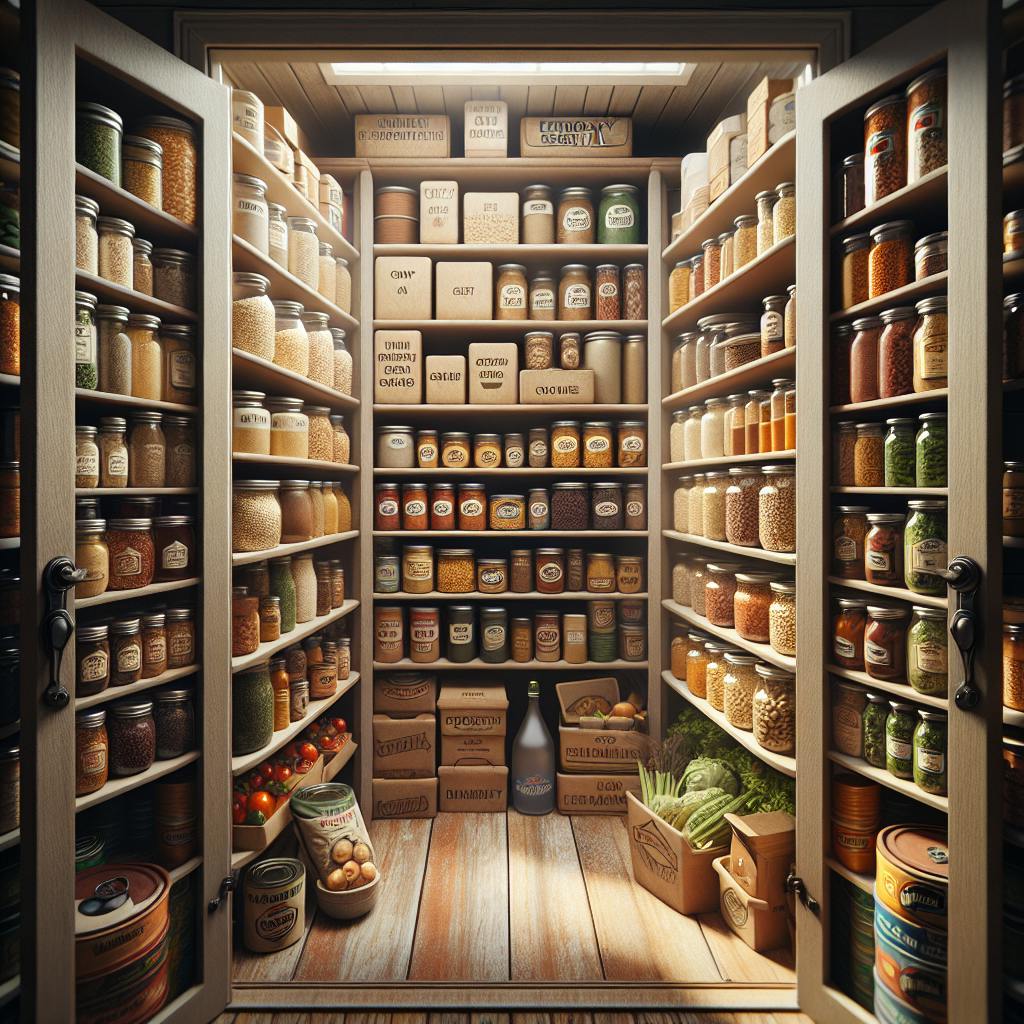When starting out with emergency preparedness, it can be overwhelming trying to build a well-rounded survival food list.
This guide will provide a balanced 30-day supply list covering all the basics, along with tips for storage and organization, so you can easily create an emergency food stockpile.
You'll learn the top 10 survival foods, what to stockpile, essential nutrients to have on hand, how to store bulk items properly, and additional considerations like backup cooking methods and comfort foods.
Introduction to Building a Survival Food List
Building an emergency food supply is an essential first step for those new to prepping. Having shelf-stable foods on hand eliminates panic if stores close or you cannot leave your home. This guide covers affordable basics to get your survival food list started.
Defining What a Survival Food List Is
A survival food list consists of non-perishable foods and water meant to sustain you and your family during an emergency when access to fresh food is limited. These shelf-stable items do not require refrigeration and have a long storage life. Examples include canned goods, grains like rice and oats, pasta, dried fruits and vegetables, nuts, protein-rich beans and legumes, powdered milk, and bottled water.
The key is choosing nutrient-dense foods that provide enough calories, macronutrients like protein and healthy fats, and micronutrients from fruits, vegetables and grains to maintain energy and health. Low-sodium and whole grain options are ideal for nutritional balance. Having at least a 30-day supply is recommended, with additional water and filtration methods.
Benefits of Creating a Survival Food List
Stocking up on non-perishables through a survival food list ensures you have essential nutrition if stores close or you cannot leave unsafe conditions. It also reduces panic and risky decisions by providing comfort that basic needs are met for the near future. Rotating and replenishing items from your list also utilizes the food during normal times, keeping it from going to waste.
Following a well-planned survival food list keeps your family nourished in an emergency while freeing up mental bandwidth to follow safety procedures. It’s an easy way to gain confidence in your preparedness efforts.
What are the top 10 survival foods?
When building your emergency food supply, focus on nutrient-dense non-perishable foods that don't require refrigeration. Here are 10 must-have items for your survival food list:
-
Whole grains like brown rice, oats, barley, and quinoa are packed with fiber and nutrients. Look for whole grain pastas and cereals too.
-
Canned goods like tuna, salmon, chicken, veggies, and fruits are convenient and last 2-5 years unopened. Choose low-sodium options when possible.
-
Nuts and seeds are calorie-dense, high in protein and healthy fats. Stash unsalted nuts and seeds like almonds, walnuts, sunflower and pumpkin seeds.
-
Dried beans and lentils are an economical source of plant-based protein and fiber. They last up to 12 months and just need water to prepare.
-
Dehydrated or freeze-dried fruits and veggies offer lightweight nutrition. Stock up on varieties like apples, bananas, sweet potatoes, green beans, corn and carrots.
-
Powdered milk and shelf-stable milk boxes can provide essential dairy nutrition and calories.
-
Canned meats like chicken, tuna, salmon and turkey can add protein variety.
-
Protein and granola bars offer an easy boost of calories and nutrients. Prioritize bars with healthy ingredients.
-
Honey and maple syrup can help sweeten foods while providing calories. Store in cool, dark places to extend shelf life.
-
Multi-vitamins help cover any nutritional gaps in your emergency food supply. Choose chewables or powdered capsules.
When building your survival food list, focus on nutrient diversity, shelf life, storage space and personal preferences. Maintain a 2 week to 3 month supply based on your household size and needs. Check expiration dates every 6 months and replenish items as needed.
What foods should I stockpile for survival?
When building your survival food supply, focus on nutrient-dense non-perishable foods that will provide energy and keep you healthy in an emergency. Here are some of the most important categories to stock up on:
Meats & Beans
Canned meats like chicken, turkey, tuna, salmon, and Vienna sausages are packed with protein to help maintain muscle mass. Canned beans are an excellent source of plant-based protein, fiber, and other key nutrients. Aim for low-sodium varieties whenever possible.
Fruits & Vegetables
Canned fruits and vegetables, as well as dried options, provide essential vitamins and minerals. Go for canned veggies with no added salt or look for low-sodium versions.
Grains, Cereals & Crackers
Grains like rice, quinoa, oats, and pasta have a long shelf life and give you an energy boost from carbohydrates. Ready-to-eat cereals, granola bars, crackers and pretzels are also handy for a quick bite. Look for whole grain options when possible.
Dairy
Powdered or canned milk, shelf-stable almond or soy milk, and powdered protein shakes or meal replacements help you meet calcium, vitamin D and other nutrient needs.
Water
Bottled water and emergency water storage containers are essential. Calculate to have at least 1 gallon per person per day for at least 3 days. Properly stored water can last for years.
Focus on nutrient-dense survival foods with a long shelf life. Calculate portions for at least 3 days per person. Check expiration dates and follow storage guidelines to keep your emergency food fresh and safe.
What are the basic foods needed to survive?
When building an emergency food supply, it's important to focus on versatile, nutrient-dense foods that don't require refrigeration. Here are some of the best options to include:
Peanut Butter - A great source of protein, fats, and calories. Look for natural peanut butters without hydrogenated oils.
Whole-Wheat Crackers - Crackers made from whole grains provide good carbohydrates as well as fiber. Pair with peanut butter for protein.
Nuts and Trail Mixes - High in protein, healthy fats, and calories. Go for unsalted nuts to control sodium intake.
Cereal - Choose whole grain cereals and granolas for fiber, carbs, and vitamins. Opt for low sugar varieties.
Granola and Power Bars - Quick, portable calories as well as protein and carbs. Check labels for excessive sugars.
Dried Fruits - Raisins, apricots, mangos and cranberries provide antioxidants, vitamins, carbs, and fiber. Prioritize unsweetened varieties.
Canned Fish - Tuna, salmon, sardines etc are packed with protein and healthy omega-3s. Pick options canned in water over oil.
Canned Vegetables - Go for low-sodium versions of veggies like carrots, peas, beans, and potatoes for essential vitamins and minerals.
Focus on nutrient-dense, non-perishable foods that pack calories, macronutrients, and vitamins to form a well-rounded emergency supply. Rotate items to ensure freshness over time.
What 5 foods can you survive on?
A balanced diet of survival food will ensure that your body is getting all the protein, carbs, minerals, and vitamins it requires to remain healthy. If you could only select five foods to survive on, the following would provide a nutritious and sustainable diet:
Potatoes
- Excellent source of complex carbohydrates, vitamin C, vitamin B6, potassium, and manganese
- Very versatile - can be baked, mashed, fried, etc.
- Long shelf life if stored properly in a cool, dark place
Kale
- Extremely nutritious green leafy vegetable packed with vitamins A, C, and K
- Also contains calcium, potassium, iron, and antioxidants
- Lasts 2-3 weeks when refrigerated
Trail Mix
- Mix of nuts, seeds, and dried fruit provides protein, healthy fats, carbs, fiber, vitamins, and minerals
- Nonperishable food with long shelf life
- Compact, lightweight, and easy to transport
Grains
- Whole grains like brown rice, quinoa, barley, and oats are nutrient-dense complex carbs
- Excellent source of fiber, protein, B vitamins, iron, magnesium, and selenium
- Last 1-2 years when stored properly in airtight containers
Beans
- Excellent plant-based protein and fiber
- Also provide iron, magnesium, zinc, potassium and folic acid
- Canned or dried beans can last years when stored in cool, dark place
sbb-itb-b932644
Essential Non-Perishable Food for Emergency Preparedness
When building an emergency food supply, non-perishable foods that can last a long time without refrigeration are essential. These pantry staples will sustain you when access to fresh foods is limited. Focus on nutrient-dense foods that provide protein, healthy fats, vitamins, and minerals.
57 Foods to Stockpile for Long-Term Sustenance
Here are 57 non-perishable foods that have a long shelf life and form a well-rounded emergency survival food list:
- Canned goods like beans, vegetables, fruits, soups, meats
- Whole grains like rice, oats, quinoa, pasta
- Nut butters and nuts like peanut butter, almonds
- Dried fruits like raisins, cranberries, apricots
- Cereals and granola
- Canned or powdered milk
- Canned fish like tuna, salmon
- Beef jerky or pemmican
- Cooking oils like olive, coconut, avocado
- Honey, maple syrup
- Salt, spices, herbs
- Bouillon cubes or soup bases
- Water and water purification supplies
- Powdered protein shakes or meal replacements
Focus on nutrient density, versatility, and your personal tastes when stocking up on these non-perishable essentials. Track expiration dates and follow the FIFO (first-in, first-out) method.
Best Prepper Food Kits for Quick Emergency Response
Prepper food kits provide grab-and-go 30 day emergency food supplies with a variety of meals and snacks. Look for variety, nutritional balance, simplicity in preparation, and good taste. Some top-rated options include:
- Mountain House Classic Bucket
- Wise Company Emergency Food Supply
- Augason Farms 30-Day Emergency Food Storage Pail
- Thrive Life 30-Day 1-Person Emergency Food Supply
- Valley Food Storage 1 Month Emergency Food Kit
Combine a basic prepper food kit with items from your pantry to assemble a complete survival food list and sustain yourself in an emergency until utilities and supply chains are restored.
Canned Varieties That Provide Essential Nutrients
Canned goods are the backbone of a survival pantry. Opt for low-sodium varieties and include options that give you:
- Protein: Canned tuna, salmon, chicken, chili with beans
- Fruits and vegetables: Canned tomatoes, pumpkin, peaches, green beans
- Fiber: Canned lentils, black beans, chickpeas
- Bone health: Canned sardines with bones
Rinsing canned goods can reduce sodium content even further.
Properly Stored Flour and Other Bulk Staples
Storing bulk items like flour, rice, oats, pasta, and quinoa for an emergency requires proper containment and climate control to prevent spoilage from moisture, insects, or rodents. Use food-grade plastic or glass containers with tight lids. Add a few oxygen absorbers to limit oxidation and spoilage. Store in a cool, dark place like a basement or pantry. An unopened bag of flour can last 6-8 months, while a properly sealed container can preserve it for over 1 year.
Following proper emergency food storage techniques helps ensure essential bulk goods in your survival pantry remain fresh until needed.
Creating a Balanced 30-Day Emergency Food Supply List
When creating an emergency food supply, it's important to have a balanced and nutritious mix of foods that will provide enough calories and nutrients to support you and your family during a crisis. Here are some best practices to follow:
Determining Calorie Needs
Consider the ages, sizes, activity levels, and any special health conditions of the people you are preparing for. As a general guideline, plan for 2,000 calories per day for each adult. Increase this amount by 300-500 calories if high activity or survival stress is expected.
Balancing Macronutrients
Aim for a balance of around 40-50% of calories from carbohydrates, 30% from fats, and 20-30% from protein sources in your 30-day supply. Tracking the macro ratios as you add items can help maintain balance.
Incorporating Variety
Include a diverse mix of flavors, textures, and both quick meal options as well as items requiring cooking. This supports both morale and meeting nutritional needs in an emergency situation. Having variety also allows for food fatigue.
Weighing Cost vs. Convenience
Compare ingredients in bulk, MREs (Meals Ready-to-Eat), and freeze-dried meal kits. Also factor in taste preferences and nutritional value for your budget. Having some convenient no-cook options can be worthwhile despite the higher cost.
Storing and Organizing Your Survival Food
Properly storing and organizing your survival food is crucial to ensure it lasts as long as possible. Here are some key tips:
Creating and Storing an Emergency Water Supply
Having an emergency supply of water is vital. Here are some methods to store water:
- Store water in food-grade plastic containers or drums. Calculate 1 gallon per person per day for at least 3 days.
- Treat water by boiling, using purification tablets, or a gravity filter to kill bacteria.
- Replace water every 6 months and store in a cool, dark place to prevent algae growth.
Ways to Keep Foods Fresh and Safe During a Power Outage
When the power goes out, keep refrigerated food safe by:
- Keeping the fridge closed as much as possible to retain cold air.
- Placing block ice or frozen gel packs inside to help keep it cool.
- Monitoring temperatures with a fridge thermometer. Toss food if above 40°F for over 2 hours.
Taking Inventory and Checking Expiration Dates
- Catalog all your stored food items and best-by dates.
- Set reminders to routinely check dates and rotate older food to the front.
- Consider an inventory system to track quantities and locations.
Proper Containers and Conditions
- Use food-grade plastic bins or Mylar bags to store dry goods.
- Use oxygen absorbers in bins to block moisture and pests.
- Store in a cool, dark place like a basement or cellar.
Following proper storage methods will keep your survival food fresh and safe for when you need it most. Check and rotate items routinely and have a water supply on hand.
Additional Tips and Considerations for Emergency Preparedness
Have Backup Cooking Methods
Having alternative cooking methods on hand such as a camp stove, grill, or even a simple pack of matches, lighters, and fuel sources can make a big difference if utilities fail. Make sure to stock up on these items along with your food supply so you can properly prepare meals when needed.
Factor in Some Comfort Foods
Don't forget to account for some comfort foods as well to help boost morale in stressful times. Having a few candy bars, coffee, snacks, or even a nip of alcohol once in awhile can go a long way for mental health. Just don't overdo it.
Regularly Rotate and Resupply
Get into the habit of regularly rotating your existing food supply and checking expiration dates. Move newly purchased items to the back and bring forward anything that is close to expiring to be used soon. Mark your calendar for reminders to replace depleted items in order to maintain a well-stocked pantry.
Building an Emergency Fund and Plan
In addition to stocking up on survival food items, it's also vitally important to build an emergency fund with cash savings as well as to put together a solid emergency plan. Having extra financial resources and knowing evacuation routes, meeting places, contacts, etc. will ensure you are fully prepared logistically for various disaster scenarios. These measures combined with your physical food supply will help maximize your readiness.
Conclusion: Best Survival Food List for Beginners
When creating a survival food list, it's important for beginners to focus on the essentials. Having a balanced, nutritious 30-day supply tailored to your needs is a reasonable goal to start. Here are some key steps to keep in mind:
-
Take inventory of what non-perishable foods you already have on hand and build your list from there. Canned goods, grains, dried beans and lentils are good staples.
-
Include foods you actually eat on a regular basis. Now is not the time to buy items you've never tried before.
-
Have a mix of proteins, fruits and vegetables, grains and starches. Variety is important for nutrition.
-
Calculate proper calorie needs for your household and pack enough food to meet those needs. Don't forget comfort foods to lift spirits.
-
Properly store foods in a cool, dry place to maximize shelf life. Check expiration dates regularly and rotate stock.
-
Supplement with freeze-dried and dehydrated options that last for years when sealed. Great for packing nutrition in compact form.
Being prepared with emergency food gives peace of mind. Start small with a basic supply, then build up gradually. Rotating and replenishing is key. With some planning, you can be ready for any situation.


